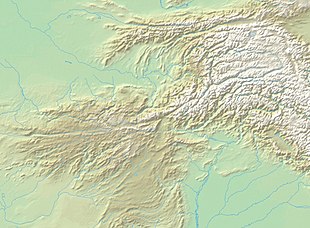
Back Toxaristan yabquluğu Azerbaijani یبغوهای تخارستان Persian توخارا يبګوس Pashto/Pushto Ябгу Тохаристана Russian Toharistan Yabguluğu Turkish 吐火罗叶护政权 Chinese
Tokhara Yabghus | |||||||||||||
|---|---|---|---|---|---|---|---|---|---|---|---|---|---|
| 625 CE–758 CE | |||||||||||||
Maximum extent of the territory controlled by the Yabghus of Tokharistan circa 625–652 CE | |||||||||||||
| Capital | Kunduz | ||||||||||||
| Religion | Buddhism[4] | ||||||||||||
| Government | Monarchy | ||||||||||||
• c. 625 CE | Tardush Shad | ||||||||||||
| Historical era | Early Medieval | ||||||||||||
• Established | 625 CE | ||||||||||||
• Disestablished | 758 CE | ||||||||||||
| |||||||||||||
| Today part of | Afghanistan Pakistan Uzbekistan Tajikistan | ||||||||||||
The Tokhara Yabghus or Yabghus of Tokharistan (simplified Chinese: 吐火罗叶护; traditional Chinese: 吐火羅葉護; pinyin: Tǔhuǒluó Yèhù) were a dynasty of Western Turk–Hephthalite sub-kings with the title "Yabghus", who ruled from 625 CE in the area of Tokharistan north and south of the Oxus River, with some smaller remnants surviving in the area of Badakhshan until 758 CE. Their legacy extended to the southeast where it came into contact with the Turk Shahis and the Zunbils until the 9th century CE.
- ^ "The account herewith quoted as 3.5. shows that this king of Tokhara had political power to control the principalities belonging to the Governors-General to the north and the south of the Hindukush, not to mention the Yuezhi Governor General." in Kuwayama, Shoshin (2005). "Chinese Records on Bamiyan: Translation and Commentary". East and West. 55 (1/4): 153, 3–5. ISSN 0012-8376. JSTOR 29757642.
- ^ Detailed list of vassal cities and regions in ancient Chinese sources: Taishan, Y. U. (2012). 歐亞學刊 新3辑 (Eurasian Studies III): Records Relevant to the Hephthalites in Ancient Chinese Historical Works. 中華書局. p. 250.
- ^ Cite error: The named reference
SKwas invoked but never defined (see the help page). - ^ Akasoy, Anna; Burnett, Charles; Yoeli-Tlalim, Ronit (14 December 2016). Islam and Tibet – Interactions along the Musk Routes. Routledge. p. 55. ISBN 978-1-351-92605-8.



